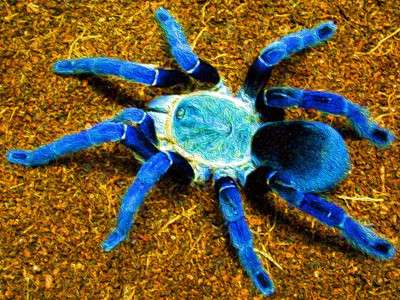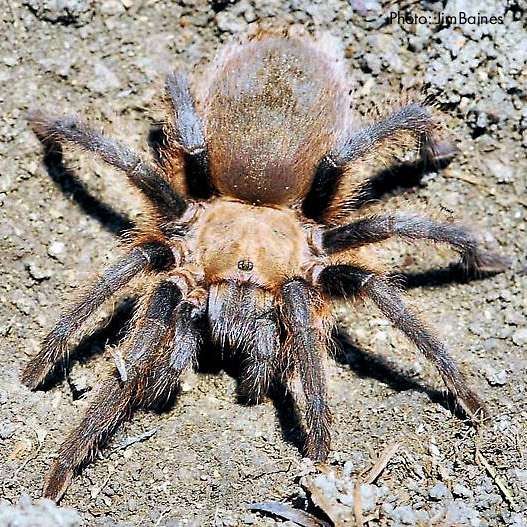
Aphonopelma chalcodes is a species of spider in the Theraphosidae family, sometimes known as the western desert tarantula, Arizona blond tarantula, or Mexican blond tarantula. Although it can be quite widespread within this range, it has a restricted distribution in the deserts of Arizona and nearby regions of Mexico. The term “blond tarantula” alludes to the carapace, which contrasts sharply with the entirely dark legs and abdomen and is densely coated in whitish hairs. These spiders also have a lengthy lifespan, a large number of offspring, and little toxicity.
Geographical Location
Aphonopelma chalcodes, often known as the desert tarantula, is widespread in the Southwestern United States, particularly in Arizona, New Mexico, and Southern California.
Habitat
The dirt in deserts is frequently home to Aphonopelma chalcodes. It constructs burrows by digging beneath stones or by exploiting rodents’ abandoned burrows. It may spend many years living in the same burrow. A. chalcodes is used to extreme weather because it thrives in the desert. It can endure the intense heat of the desert because it does not need a lot of water to survive.
Description of the body
Even while mature A. chalcodes exhibit sexual dimorphism, it is not as extreme as in other species.
Diameter
Males range from 49 to 61 mm in diameter, while females have a diameter of 49 to 68 mm and a leg span of about 98 mm. Like other tarantula species, desert tarantulas have a completely hair-covered body.
Abdomen and Cephalothorax
They have two body parts, the cephalothorax and the abdomen, like other spiders do. The abdomen ranges from dark brown to black, whereas the cephalothorax is grey to dark brown. Below the tips of each of the eight legs is a pad made of iridescent hair. By biting their prey with their chelicerae’s fangs, tarantulas inject poison into their victims.

Behavior
Desert tarantulas are nocturnal, solitary spiders. During the day, they typically hide in their burrows, beneath rocks, or in abandoned holes. They conceal themselves because they are more susceptible to predators like birds and snakes during the day, and also because most of their prey are nocturnal. Males can be spotted aggressively looking for females between dusk and dawn between June and December.
Feeding Habits
Aphonopelma chalcodes hides out in its burrow for the majority of the day. It comes out at dusk and starts looking for food. Lizards, crickets, beetles, grasshoppers, cicadas, and caterpillars are among the foods consumed.
Importance
Role in ecosystems
Through their predatory habits, these spiders probably have an impact on the insect population. It could be a potential prey species. A. Chalcodes may have some beneficial effects on the parasite and predator populations.
Positive Importance for Humans
For humans, Aphonopelma chalcodes has minimal economic value. Due to its gentle temperament and low maintenance requirements, it is occasionally sold as a pet. By consuming beetles, grasshoppers, millipedes, and other spiders, desert tarantulas also manage pests.
Negative Importance for Humans
The effects of Aphonopelma chalcodes on people are not particularly harmful. Its bite is unpleasant, but it is not particularly poisonous. The venom is comparable to that from a bee sting or a mosquito bite.
Keeping as Pet
Housing
For desert blond tarantulas, a 5- to 10-gallon plastic or glass tank with a safe lid and airflow is ideal. Generally speaking, the tank should have a length three times the spider’s leg span, a width two to three times the leg span, and a height of approximately one foot. Avoid using excessively tall tanks because these spiders can get injuries from falls from vast heights and can climb.
Although these tarantulas are highly resilient to temperature changes because they are desert dwellers, it is advisable to keep the tank between 75 and 80 degrees Fahrenheit. A hydrometer can be used to measure the humidity level, which should be between 65 and 70 percent. Include something the spider can use as refuge in the tank, such as cork bark, a half-hollow wood, a small clay flower pot on its side, or something similar.
Exercise
Like every animal, tarantulas need exercise to maintain a healthy body and stave off disease. They don’t need an excessive quantity, though. They ought to be able to acquire the physical activity they require as long as their enclosure is big enough.
Grooming
Tarantulas that are blond in the desert groom themselves by molting. Additionally, they typically don’t need your assistance at this time. Just make sure their surroundings are at the right humidity and temperature to keep them at ease.
Table





